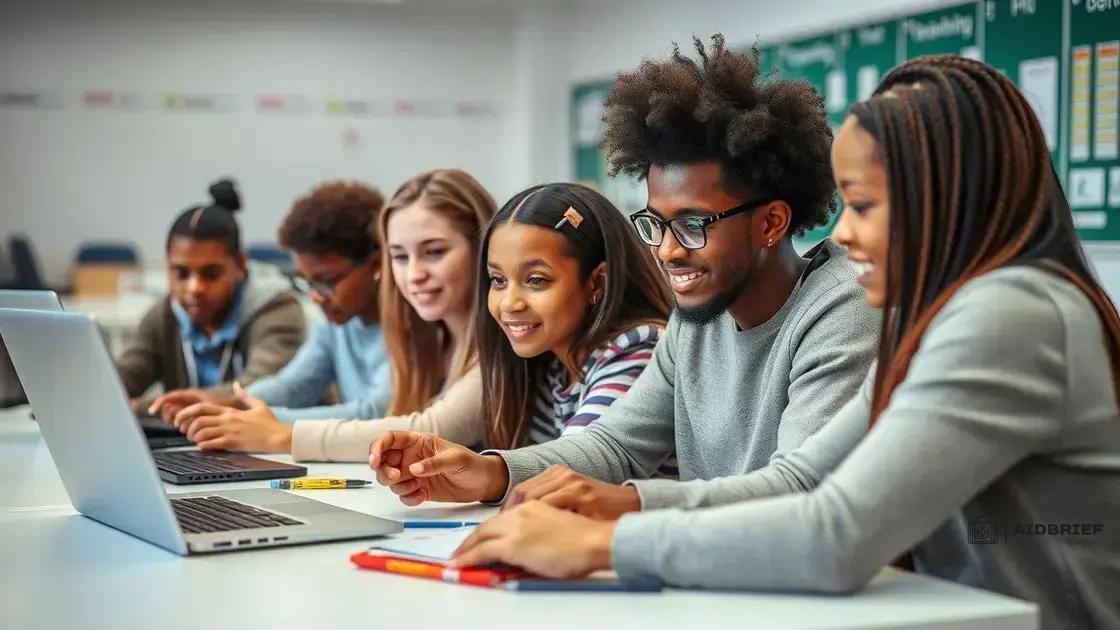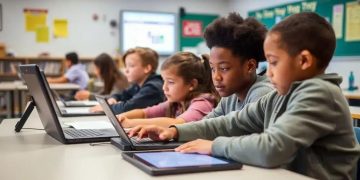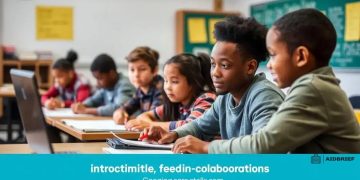State-level education policy changes enacted that matter

State-level education policy changes enacted focus on personalized learning, technology integration, and social-emotional support to ensure equity and improve student outcomes across diverse educational settings.
State-level education policy changes enacted are transforming the landscape of education across the country. Have you ever wondered how these changes affect your child’s learning experience? Let’s dive into the recent developments and their implications.
Understanding recent education policy changes
Understanding recent education policy changes is essential for students, parents, and educators. These changes can significantly impact how schools operate and how students learn.
Key Factors Influencing Changes
Several factors drive policy changes at the state level. These can include:
- Increased focus on standardized testing outcomes
- Changes in funding allocations
- Responses to community needs and feedback
By analyzing these factors, we can better grasp why certain reforms are prioritized.
Examples of Recent Changes
Many states have enacted policies aimed at improving education quality. For instance, some states have introduced initiatives for better teacher training, while others focus on enhancing technology access in classrooms. Moreover, you might have seen changes in curriculum standards to better prepare students for future challenges.
Another important element involves revising graduation requirements. An effort to ensure students are career-ready includes introducing vocational programs alongside traditional academics. This dual approach aims to cater to diverse student interests and skills.
Moreover, the adaptation of remote learning methods sparked significant changes. Schools had to pivot quickly during the pandemic, and many continue to incorporate online resources into their education delivery.
Impact on Students and Communities
The implications of these policy changes are profound. As schools implement new strategies, it’s crucial to assess how effectively they serve students. Are they enhancing learning opportunities? Are certain groups being excluded?
- Improving access to mental health resources
- Encouraging community involvement in educational decisions
- Integrating parental feedback into policy-making
A collaborative approach ensures that education remains responsive to the needs of every student, ultimately fostering a more inclusive environment.
By understanding these recent education policy changes, stakeholders can actively participate in discussions and advocate for improvements that truly benefit students and their communities.
Impact of state-level changes on local schools
The impact of state-level changes on local schools is profound and can be seen in various aspects of education. These changes, often dictated by new policies, regulations, or funding, directly influence how schools operate and how teachers educate students.
Funding Adjustments
One major area affected is funding. State-level changes can either increase or decrease funding for local schools. This shift often leads schools to rethink their budgets and make tough decisions about programs and resources.
- Increased funding can improve educational resources.
- Decreased funding may lead to cuts in staff or programs.
- Local schools may seek alternative funding sources, such as grants.
When schools receive more financial support, they can invest in enhanced classroom technologies and instructional tools, which benefit student learning.
Curriculum Revisions
Another significant impact is on curriculum. State policies often mandate changes to what subjects are taught and how they are presented. As a result, local schools may need to adjust their lesson plans and classroom activities accordingly. This requirement pushes educators to be more flexible and proactive in adapting to new standards.
For instance, states may implement new STEM programs aimed at boosting student interest in science and technology. Schools must then incorporate these topics into their existing curricula.
Additionally, the implementation of updated literacy guidelines requires teachers to focus on different reading strategies. This shift can be challenging but ultimately aims to improve student outcomes.
Student Performance and Standards
Changes in state-level assessments also significantly affect local schools. New testing standards are often put in place to evaluate how well students meet educational goals. Schools must, therefore, ensure that they are preparing students adequately for assessments that could influence their funding and reputation.
- Standardized tests may dictate classroom focus and teaching methods.
- Performance results can lead to school closures or restructuring.
- Improving student performance requires strong, supportive policies.
The pressure to perform well in these assessments influences not only the curriculum but also the overall teaching methods that educators use.
In summary, the impact of state-level changes is evident in many facets of local education systems. Understanding these effects helps communities stay informed and engaged in their schools’ operations.
Key challenges facing educational reforms

The key challenges facing educational reforms often hinder the progress of improving schools and educational outcomes. These challenges can come from various sources, including policymakers, schools, and communities.
Resistance to Change
One major challenge is the resistance to change from educators and the community. Many teachers may feel comfortable with existing practices and may be hesitant to adapt to new methods introduced by reforms.
- Fears of the unknown and new responsibilities
- Concerns over the effectiveness of new programs
- Lack of training and support for teachers
Overcoming this resistance requires comprehensive training programs and clear communication about the benefits of changes.
Funding Issues
An ongoing issue is securing adequate funding for new initiatives. Many schools struggle with limited budgets, making it difficult to implement reforms effectively. When funding is inadequate, schools cannot acquire necessary resources, hire additional staff, or invest in new technologies.
Additionally, differences in funding models can lead to disparities between schools, affecting the quality of education students receive. Communities need to advocate for fair funding to support educational equity.
Equity and Access
Ensuring equity and access to education remains a critical challenge. Reforms may inadvertently widen gaps between different student populations if not carefully designed. For example, students in low-income areas might not have the same access to advanced courses or enrichment programs as their peers in wealthier districts.
- Policies must include strategies to address disparities.
- Community involvement is essential for identifying local needs.
- Targeting resources to underprivileged areas can level the playing field.
Effective communication and collaboration between all stakeholders, including parents, teachers, and community members, are essential for fostering a more equitable educational system.
Finally, maintaining a focus on student outcomes is crucial. While reforms aim to enhance education, it’s vital to monitor their impact on actual student performances. Evaluating the effects of these changes can help identify areas for improvement.
Examples of successful policy implementations
Exploring examples of successful policy implementations provides valuable insights into how effective changes can transform educational systems. When done right, these policies serve as models for other regions looking to improve their schools.
Increased Funding for Low-Income Schools
One notable success comes from states that have increased funding specifically for low-income schools. By reallocating resources, these states have witnessed remarkable improvements in student performance.
- More qualified teachers were hired.
- Enhanced educational materials became available.
- Students benefitted from after-school programs that support their learning.
Such financial support is critical in leveling the playing field among schools, particularly in underfunded areas.
STEM Initiatives in Various States
Another great example is the implementation of STEM (science, technology, engineering, and math) initiatives in schools across the country. These programs focus on integrating STEM into the curriculum early on, ensuring that students are prepared for future jobs.
In many instances, schools teamed up with local businesses to foster real-world experience. This collaboration helps students understand how their education applies outside the classroom.
Inclusive Education Policies
Moreover, some districts have successfully adopted inclusive education policies that ensure students with disabilities receive education alongside their peers. By adapting teaching methods and classroom environments, educators foster a culture of acceptance and support.
- Teacher training programs focused on inclusivity.
- Collaboration between special education and general education teachers.
- Increased access to resources for all students.
These strategies maximize learning opportunities, demonstrating that inclusion benefits everyone in the school community.
Community Engagement Programs
Lastly, policies encouraging community engagement have also proven successful. When schools involve families and local organizations in the education process, students often achieve better outcomes.
Programs that promote parental participation in school events and decision-making foster a sense of belonging. This involvement encourages students to value their education and strive for success.
Future trends in education policy
Future trends in education policy are shaping the direction of schools and learning environments. As society evolves, so do educational needs and expectations, prompting policymakers to innovate and adapt.
Personalized Learning Approaches
One emerging trend is the shift towards personalized learning. This approach tailors education to meet individual student needs, allowing for different learning paces and styles. Schools are beginning to implement adaptive technologies that gather data on student performance and adjust learning paths accordingly.
- Use of learning analytics to track student progress.
- Developing customized lesson plans based on student interests.
- Incorporating student feedback into learning experiences.
With personalized learning, students feel more engaged and motivated, leading to improved outcomes.
Integration of Technology
Another significant trend is the increased integration of technology in the classroom. Educational institutions are adopting blended learning models, combining traditional teaching methods with online resources. This integration enhances educational accessibility and flexibility.
Schools are providing devices like tablets and laptops to students, ensuring they have the tools needed to succeed in a tech-driven world. Furthermore, virtual and augmented reality experiences are being introduced to create immersive learning environments.
Focus on Social-Emotional Learning (SEL)
In addition to academic success, there is a growing emphasis on social-emotional learning (SEL). Schools are recognizing the importance of developing students’ emotional intelligence and resilience. By integrating SEL into the curriculum, educators can support students’ mental health and well-being.
- Implementing programs that promote relationship building.
- Providing training for teachers on SEL techniques.
- Creating a supportive school culture that prioritizes student well-being.
These initiatives help students navigate challenges both inside and outside the classroom, preparing them for success in life.
Equity in Education
Future policies also focus on ensuring equity in education. This includes addressing disparities in funding and resources among schools. Policymakers are working to create more equitable systems that provide all students with access to quality education, regardless of their background.
Efforts to close achievement gaps through targeted programs are becoming more prevalent. This trend emphasizes the need for partnerships between schools, communities, and organizations to create supportive networks for students.
In conclusion, the landscape of education is transforming with new policies and innovative approaches. As we look to the future, personalized learning, technology integration, and social-emotional learning will shape the experiences of students. Equity in education remains a priority, ensuring that all learners have access to quality education, regardless of their circumstances. By embracing these trends, we can create a more inclusive and effective education system that prepares students for success in a rapidly changing world.
FAQ – Frequently Asked Questions about Education Policy Changes
What is personalized learning?
Personalized learning is an approach that tailors education to meet each student’s individual needs, allowing them to learn at their own pace.
How does technology integration improve education?
Integrating technology into classrooms enhances learning by providing students with access to digital resources and interactive tools that support their education.
Why is social-emotional learning important?
Social-emotional learning helps students develop emotional intelligence and resilience, which are essential for success in school and life.
How can schools ensure equity in education?
Schools can ensure equity by addressing funding disparities, providing resources to underprivileged areas, and implementing inclusive policies that support all students.





